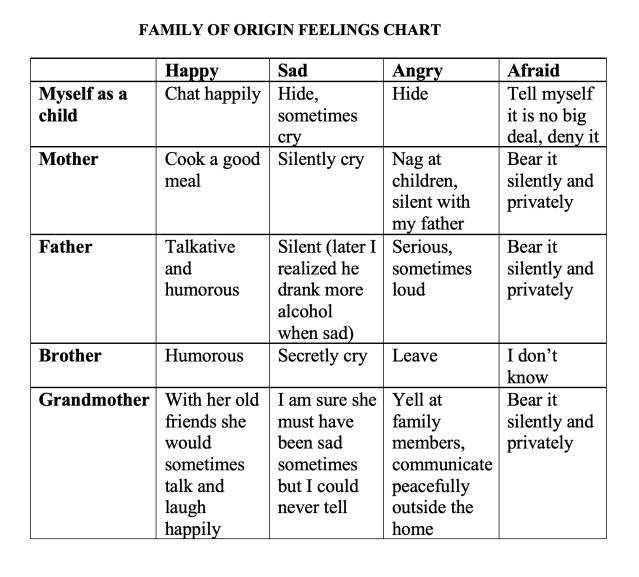Emotions
A Chart to Jumpstart Emotional Self-Knowledge
History does not have to repeat itself.
Posted February 4, 2023 Reviewed by Vanessa Lancaster
Key points
- While growing up, how each family member expressed emotions likely influenced your emotional responses as an adult.
- Charting how you experienced your family members' emotions can reveal patterns that persist into adulthood.
- Insight into your past and current emotional patterns allows you to choose how you want to react to situations as an adult.
Erik Erikson, the pioneering researcher on human development, said, “The more you know yourself, the more patience you have for what you see in others.”
A powerful tool for knowing yourself emotionally is to make a chart of how each emotion was expressed by each member of your family, including yourself when you were growing up. This history can have a big influence on the way you express your emotions, your ability to handle your children’s emotions, and all your relationships.
The Chart
Here is a sample chart from a mom who consulted me about a challenge she faced dealing with feelings of anger and fear within herself and when expressed by her children. The chart has members of her family of origin down one side and different emotions across the top. This example is simplified to contain four emotions, but you can include as many as you like. My client included everyone in her immediate family, including her grandmother, who lived with her for many years. Make your own, and you will likely uncover family patterns for each emotion and notice which patterns are still active within you today.

New Discoveries
After she filled in her chart, this mother said that she had never realized how much secrecy there was about emotions in her family. She said,
I am accustomed to putting emotions away in my heart, which I recognize now is very unhealthy. It’s a surprise to see the history of it so clearly. I want to create a new pattern to share with my children and my husband, and even my parents.
Faced with difficult emotions, I want to first realize their existence, then accept them, then express them as calmly as I can, letting the people close to me know how I feel.
In the following weeks, she used the chart to motivate a deliberate shift from a family pattern of denial to a new family culture of healthy expression.
Emotions Then and Now
Sometimes patterns change over time, but not always in a healthy direction. Another person who shared their chart with me said,
I see that I was always a child who let out all my emotions directly, even if I was the only one in the family who did. But after I grew up, I began to suppress my negative emotions more and more, like my parents did, and only express positive emotions.
When I asked her why she thought this change occurred, she said,
I have adult responsibilities now and can’t show my feelings freely like a child. But I am not sure this is right, because I feel very lonely. I wish I could be more open, as I was when I was younger. I think it would help me with my marriage and my children.
Common Themes
Everyone’s family feelings chart is different, but I have noticed certain themes over and over in these emotional histories:
- Happy emotions are expressed most easily by family members unless there is a strong family pattern of sadness that makes it hard for others to show joy.
- Silence is the most common way to suppress emotion; other common ones are withdrawing from the family and drinking.
- Parents’ emotions have a big impact on children, even when they are suppressed.
- Emotions are often released indirectly, for example, with coldness or sarcasm for anger or blaming others to deflect feelings of shame.
- Many people have a double entry in the chart: They hold in their emotions tight until they explode out in yelling, nagging, hitting, shaming, or threatening.
- Many children grew up feeling they had to be the “good kid” in the family, in other words, an unemotional child, because of the extreme emotions of other family members. Others responded to intense family emotions by being disobedient or irresponsible.
Update Your Chart
It’s never easy or instantaneous to change a pattern, especially one ingrained since childhood. But seeing the pattern in black and white in one chart can help set the course for changes. How do you want to react to each emotion now that you are grown?


